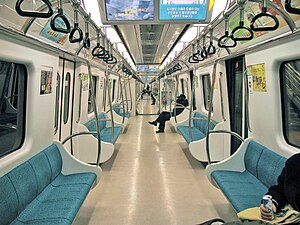Daejeon Metro
| Daejeon Metro | |||
|---|---|---|---|
 | |||
 | |||
| Overview | |||
| Locale | Daejeon, South Korea | ||
| Transit type | Rapid transit | ||
| Number of lines | 1 | ||
| Number of stations | 22 | ||
| Daily ridership | 110,307 (2019) [1] | ||
| Annual ridership | 40,262,211 (2019)[1] | ||
| Website | http://www.djet.co.kr/ | ||
| Operation | |||
| Began operation | 16 March 2006 | ||
| Operator(s) | Daejeon Metropolitan Express Transit Corporation | ||
| Number of vehicles | Hyundai Rotem Metro cars | ||
| Technical | |||
| System length | 22.74 km (14.13 mi) | ||
| Track gauge | 1,435 mm (4 ft 8+1⁄2 in) | ||
| |||
| Daejeon Metro | |
| Hangul | |
|---|---|
| Hanja | |
| Revised Romanization | Daejeon dosicheoldo |
| McCune–Reischauer | Taejŏn tosich'ŏlto |
Daejeon Metro (Korean: 대전도시철도; Hanja: 大田都市鐵道; RR: Daejeon dosicheoldo) is the rapid transit system of Daejeon, South Korea, operated by the Daejeon Metropolitan Express Transit Corporation (DjeT, or Daejeon Metro). The single-line subway network first opened in 2006 with 12 stations. The line was expanded in 2007 and it now consists of one line, 22 operating stations, and 22.6 kilometres (14.0 mi) of route.[citation needed]
History
After the city's administrative district was expanded in 1995, plans were announced in February 1996 for a five-line metro service totaling 102.3 kilometres (63.6 mi). Construction of Line 1 began in October 1996 and was scheduled to be completed by 2003, but completion was delayed by right-of-way acquisition and constrained finances in the wake of the Asian financial crisis.[2]
Lines
| Line Name English |
Line Name Hangul |
Starting Station(s) | Ending Station(s) | Stations | Total Length in km |
| 1 | 1호선 | Panam | Banseok | 22 | 22.7 |
Line 1
Line 1 was initially designed to be 22.6 kilometres (14.0 mi) long, connecting the old and new town centers.[2] It opened in two phases and a third is planned:
- 16 March 2006: Line 1 Phase 1 opened (Panam ↔ Government Complex)
- 17 April 2007: Line 1 Phase 2 complete, fully opened (Panam ↔ Banseok)
- 2029: Tentative opening date of extension from Banseok to Government Complex Sejong[3]
The track leads from Banseok Station in Yuseong-gu to Panam Station in Dong-gu.
Line 2
The construction of a Line 2 was planned to begin in 2008, but is delayed because government funding has been diverted to other projects.[4]
"Line 2" will have construction begin "soon" according to statements from the Daejeon Metropolitan Government. The new "Line 2" will be a mix of ground level and elevated track. Experts hope to have test portions of the line operational by 2018, but estimates show the full line will probably not be finished until after 2021.[5]
There have been plans to build line 2 as a magnetic levitation train similar to the German M-Bahn or the Japanese HSST.[4][6] The current technical design, however, is not open to the public.[4]
See also
References
- ^ a b http://www.djet.co.kr/kor/board.do?menuIdx=541&bbsIdx=16268
- ^ a b Mun, Jinsu; Kim, Hun, eds. (2013). "2. History of the Urban Railway Development in South Korea". Korea's Railway Development Strategies. Goyang, Republic of Korea: Korean Transport Institute. pp. 30–31. ISBN 978-89-5503-559-9. Retrieved 22 May 2017.
- ^ 박, 희윤 (18 April 2019). 대전~세종 광역철도 건설…2029년 완공목표: 반석~정부세종청사 14㎞ 연결…2029년 완공목표, 국가철도망계획 반영 추진. 서울경제 (in Korean). Retrieved 25 April 2019.
- ^ a b c 네이버 :: 지식iN
- ^ http://www.daejeon.go.kr/drh/drhStoryDaejeonView.do?boardId=blog_0001&menuSeq=1628&categorySeq=295&ntatcSeq=1038516&pageIndex=1
- ^ Maglev Transrapid Magnetschnellbahn | Maglev in South-Korea
External links
- Official website (in Korean)
- Official website (in English)
- Network Map

